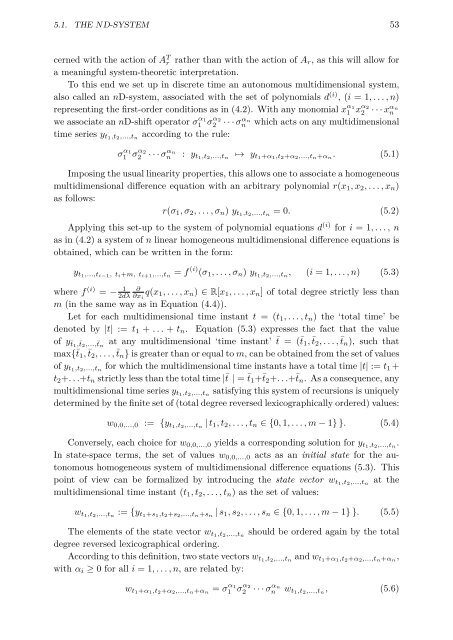link to my thesis
link to my thesis
link to my thesis
Create successful ePaper yourself
Turn your PDF publications into a flip-book with our unique Google optimized e-Paper software.
5.1. THE ND-SYSTEM 53<br />
cerned with the action of A T r rather than with the action of A r , as this will allow for<br />
a meaningful system-theoretic interpretation.<br />
To this end we set up in discrete time an au<strong>to</strong>nomous multidimensional system,<br />
also called an nD-system, associated with the set of polynomials d (i) ,(i =1,...,n)<br />
representing the first-order conditions as in (4.2). With any monomial x α1<br />
1 xα2 2 ···xαn n<br />
we associate an nD-shift opera<strong>to</strong>r σ α1<br />
1 σα2 2 ···σαn n which acts on any multidimensional<br />
time series y t1,t 2,...,t n<br />
according <strong>to</strong> the rule:<br />
σ α1<br />
1 σα2 2 ···σαn n : y t1,t 2,...,t n<br />
↦→ y t1+α 1,t 2+α 2,...,t n+α n<br />
. (5.1)<br />
Imposing the usual linearity properties, this allows one <strong>to</strong> associate a homogeneous<br />
multidimensional difference equation with an arbitrary polynomial r(x 1 ,x 2 ,...,x n )<br />
as follows:<br />
r(σ 1 ,σ 2 ,...,σ n ) y t1,t 2,...,t n<br />
=0. (5.2)<br />
Applying this set-up <strong>to</strong> the system of polynomial equations d (i) for i =1,..., n<br />
as in (4.2) a system of n linear homogeneous multidimensional difference equations is<br />
obtained, which can be written in the form:<br />
y t1,...,t i−1, t i+m, t i+1,...,t n<br />
= f (i) (σ 1 ,...,σ n ) y t1,t 2,...,t n<br />
, (i =1,...,n) (5.3)<br />
∂<br />
where f (i) = − 1<br />
2dλ ∂x i<br />
q(x 1 ,...,x n ) ∈ R[x 1 ,...,x n ] of <strong>to</strong>tal degree strictly less than<br />
m (in the same way as in Equation (4.4)).<br />
Let for each multidimensional time instant t =(t 1 ,...,t n ) the ‘<strong>to</strong>tal time’ be<br />
denoted by |t| := t 1 + ... + t n . Equation (5.3) expresses the fact that the value<br />
of y¯t 1,¯t 2,...,¯t n<br />
at any multidimensional ‘time instant’ ¯t = (¯t 1 , ¯t 2 ,...,¯t n ), such that<br />
max{¯t 1 , ¯t 2 ,...,¯t n } is greater than or equal <strong>to</strong> m, can be obtained from the set of values<br />
of y t1,t 2,...,t n<br />
for which the multidimensional time instants have a <strong>to</strong>tal time |t| := t 1 +<br />
t 2 +...+t n strictly less than the <strong>to</strong>tal time |¯t | = ¯t 1 +¯t 2 +...+¯t n . As a consequence, any<br />
multidimensional time series y t1,t 2,...,t n<br />
satisfying this system of recursions is uniquely<br />
determined by the finite set of (<strong>to</strong>tal degree reversed lexicographically ordered) values:<br />
w 0,0,...,0 := {y t1,t 2,...,t n<br />
| t 1 ,t 2 ,...,t n ∈{0, 1,...,m− 1}}. (5.4)<br />
Conversely, each choice for w 0,0,...,0 yields a corresponding solution for y t1,t 2,...,t n<br />
.<br />
In state-space terms, the set of values w 0,0,...,0 acts as an initial state for the au<strong>to</strong>nomous<br />
homogeneous system of multidimensional difference equations (5.3). This<br />
point of view can be formalized by introducing the state vec<strong>to</strong>r w t1,t 2,...,t n<br />
at the<br />
multidimensional time instant (t 1 ,t 2 ,...,t n ) as the set of values:<br />
w t1,t 2,...,t n<br />
:= {y t1+s 1,t 2+s 2,...,t n+s n<br />
| s 1 ,s 2 ,...,s n ∈{0, 1,...,m− 1}}. (5.5)<br />
The elements of the state vec<strong>to</strong>r w t1,t 2,...,t n<br />
should be ordered again by the <strong>to</strong>tal<br />
degree reversed lexicographical ordering.<br />
According <strong>to</strong> this definition, two state vec<strong>to</strong>rs w t1,t 2,...,t n<br />
and w t1+α 1,t 2+α 2,...,t n+α n<br />
,<br />
with α i ≥ 0 for all i =1,...,n, are related by:<br />
w t1+α 1,t 2+α 2,...,t n+α n<br />
= σ α1<br />
1 σα2 2 ···σαn n w t1,t 2,...,t n<br />
, (5.6)

















